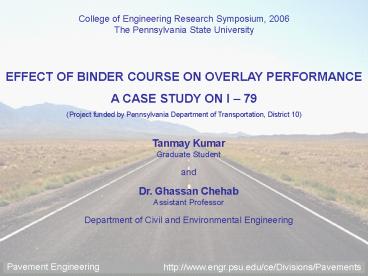EFFECT OF BINDER COURSE ON OVERLAY PERFORMANCE - PowerPoint PPT Presentation
1 / 16
Title: EFFECT OF BINDER COURSE ON OVERLAY PERFORMANCE
1
College of Engineering Research Symposium,
2006 The Pennsylvania State University
EFFECT OF BINDER COURSE ON OVERLAY PERFORMANCE A
CASE STUDY ON I 79 (Project funded by
Pennsylvania Department of Transportation,
District 10)
Tanmay Kumar Graduate Student and Dr. Ghassan
Chehab Assistant Professor Department of Civil
and Environmental Engineering
2
In this presentation
- Introduction
- Pavements
- Pavement distresses
- I 79 in Butler county, PA
- Existing pavement
- Rehabilitation techniques
- Experimental evaluation
- Continuing work
- Questions
3
What is a Pavement?
- A multi layer system that distributes the
vehicular loads over a larger area
4
Pavement Distresses
- Due to loading and / or structure
- Rutting or Permanent deformation
- Fatigue cracking (Bottom-up cracking)
- Edge-of-wheel cracking (Top-down cracking)
5
Interstate 79 in Butler County
- AC over PCC pavement
- Wheel-path (top-down) cracking
6
Rehabilitation Techniques
- Typical Place 1.5 in. AC overlay over existing
AC - Experimental Place 2 in. binder layer between
existing AC and new 1.5 in. AC
7
Objectives and Methodology
- Objective
- Evaluate effectiveness of binder layer in
preventing or controlling pavement distresses - Methodology
- Full scale field testing
- Accelerated laboratory testing
- Analytical tools
- Finite Element Analysis
- M-E Design Guide
- Linear Elastic Multi-layer Analysis
8
Accelerated Pavement TestingModel Mobile Load
Simulator at 1/3rd Scale (MMLS3)
9
MMLS3
10
MMLS3
11
But I thought thicker members were always
stronger
12
MMLS3
- Why does inclusion of binder layer reduce rutting
resistance? - Higher edge-of-wheel shear stresses
- Edge-of-wheel top-down cracking
- Material deficiencies
13
Finite Element Analysis
No binder layer
4 in. binder layer
14
Performance Prediction
- Models provided in the M-E Design Guide
- Increase in binder layer thickness
- Marginal increases rutting
- Negligible effect on Fatigue cracking
- Top-down cracking highly sensitive
15
Continuing Work
- Additional tests using MMLS3 at moderate
temperatures to simulate wheel-edge cracking
without rutting - Advanced 3D FE models incorporating
viscoplasticity to simulate growth of rutting - Evaluate alternate mix designs for binder layer
- Relate MMLS3 axles to actual traffic
- Indirect tension (IDT) tests to evaluate thermal
cracking potential of both mixes
16
Questions































